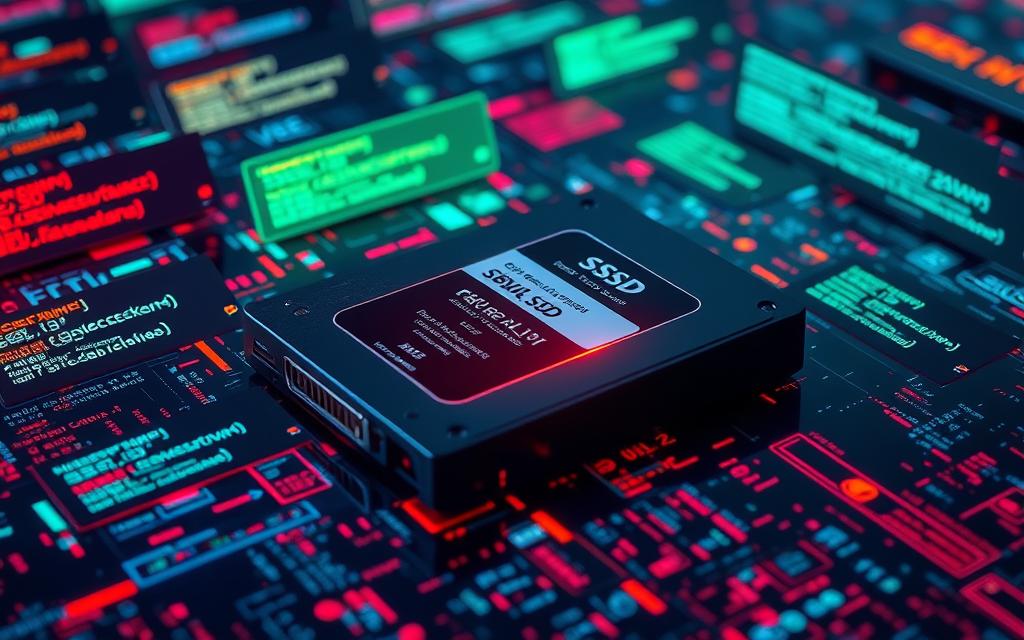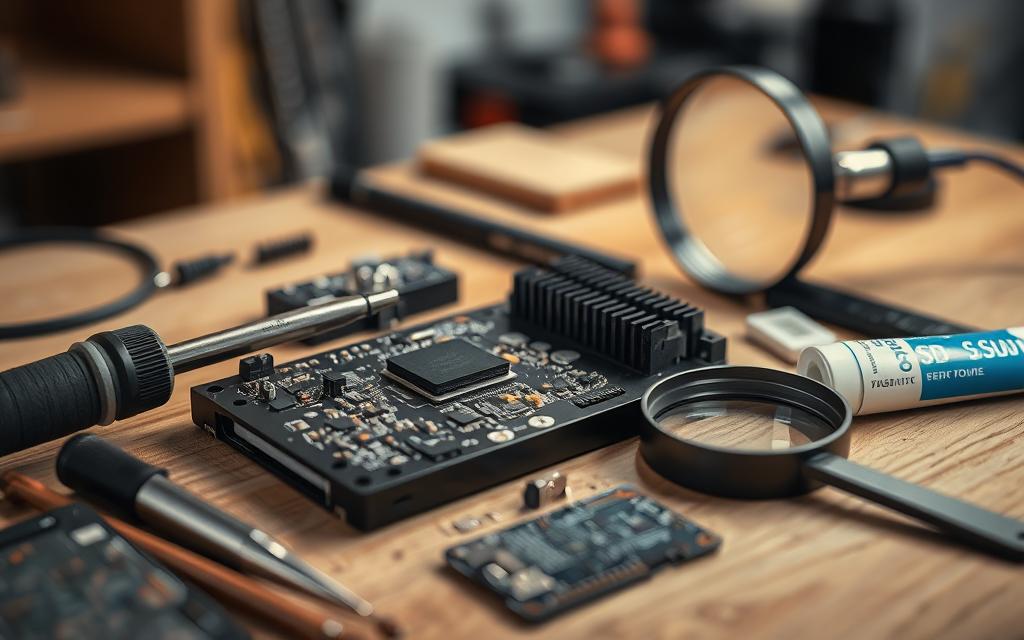SSD drives are becoming more popular due to their speed and efficiency. They are great for gamers and everyday users. But, like all technology, SSDs can sometimes have problems. It’s important to know how to fix these issues quickly to avoid losing data.
We will go through common issues with SSDs, including how to spot and fix them. Our goal is to help you keep your SSD running well for longer. If you need more detail on fixing SSDs, have a look at this detailed SSD repair guide.
Understanding SSD Drives and Common Issues
Solid-state drives, or SSDs, are a big step forward in storing data. They don’t use spinning disks like old hard drives (HDDs) do. Instead, SSDs use special chips to keep data safe. This makes them faster, more reliable, and they use less power. This is why SSDs are better for storing data.
What is an SSD Drive?
An SSD is a storage device that uses flash memory, which makes it really fast at reading and writing data. Unlike older HDDs, SSDs have no moving parts. This means there’s less chance they’ll break. That’s one reason why people who love tech and professionals prefer them.
Key Benefits of SSDs over HDDs
There are many reasons why SSDs are better than HDDs:
- Speed: SSDs allow you to access your files and transfer them quickly.
- Reliability: Without moving parts, SSDs are less likely to get damaged and lose data.
- Energy efficiency: SSDs use less power, which is great for laptops and portable devices.
- Durability: SSDs can handle bumps and shakes better, making them good for all kinds of uses.
Common Problems Associated with SSDs
Though SSDs have many advantages, they can have issues too. Some common problems are:
- The computer might not recognize the drive anymore.
- You could see messages asking you to format the disk or errors when accessing files.
- The drive’s performance might get worse over time, especially if you use it a lot.
- You might notice signs that you could lose data, like delays when saving files or the system crashing often.
To avoid these problems, it’s important to back up your data often. You should also update the drive’s software and keep an eye on its health. Knowing the signs of trouble can help you fix issues before they become big problems.
How to Recognise a Corrupted SSD
It’s important to spot a corrupted SSD early to stop more data loss. You should know the signs – error messages, slow performance, and data loss. Knowing these can help you fix issues fast.
Error Messages Indicating Corruption
Error messages from your SSD are like warnings. Messages saying “No bootable medium” or “Your PC won’t boot” are bad news. They mean your drive may have severe issues. It’s crucial to act quickly when you see these warnings to limit damage.
System Crashes and Performance Issues
System crashes, freezing, and slowness are signs of trouble. These issues often come from corruption. Quick action is needed to stop data loss. Working on solutions early improves your computer’s health.
Signs of Data Loss and Files Disappearing
A corrupted SSD will show clear signs of data issues. You might find files unreadable or missing. Sometimes, files become locked, stopping you from making changes. Seeing these signs means you need to act to fix your SSD. For help with SSD troubles, look at this handy guide.

Steps for Effective SSD Drive Repair
Fixing an SSD involves smart troubleshooting steps. There are many ways to solve issues with SSDs. Here are the main steps for effective SSD drive repair:
Connect SSD to Another Device or Port
Firstly, check the SSD’s connections. Try connecting the SSD to a different device or port. This might solve the problem if the SSD works, making troubleshooting easier.
Update SSD Drivers and Firmware
Outdated drivers can slow down an SSD. It’s important to keep firmware up to date. To update drivers, open the Device Manager in Windows. Follow simple steps. This keeps your system running well and prevents problems. For more help, look at this guide.
Run CHKDSK to Identify and Fix Errors
The CHKDSK command helps fix SSD errors. Use Command Prompt to run it. This checks and fixes filesystem issues. It’s key for keeping an SSD in good shape. It helps spot and solve performance problems.
Advanced Techniques for SSD Drive Repair
Fixing a corrupted SSD might need more advanced steps. There are many techniques, like using special software tools. These can help get back lost data.
Using the Open-Source TestDisk Tool
TestDisk is a great open-source recovery tool for getting back lost partitions. It also makes disks that won’t start work again. You can download TestDisk for free. Then, follow some steps to use it:
- Download and install TestDisk from the official website.
- Run the software and select the SSD that’s not working right.
- Pick the analysis option to check the disk for messed-up files.
- Do what the software tells you to recover lost parts or files.
- Save the files you need to a different place for keeping them safe.
This approach usually takes between 5-15 minutes, based on how bad the corruption is. People who like easy-to-use stuff might like the SSD repair software from EaseUS, too.
Employing Professional Data Recovery Software
For really bad data loss, you need professional data recovery software. Data recovery software like Wondershare Recoverit and EaseUS Data Recovery Wizard are easy to use. They help get back lost data from SSDs that are messed up or can’t be accessed. Here’s what to do:
- Download and set up the software you choose.
- Open the software and pick the SSD that’s not working to check it.
- Start a deep scan. It might take a bit of time.
- Look at the files you can get back after the scan is done.
- Choose the files you want and start getting them back.
The EaseUS Data Recovery Wizard works with Windows 10, 8, and 7. It’s made to get your data back quickly, with just a few clicks, and keep your downtime low.
Using tools like TestDisk and professional data recovery software can really boost your chances of fixing your SSD and getting your data back. For detailed help and step-by-step guides on fixing corrupted SSDs, check out this useful link.
Conclusion
We have looked at the key points of fixing an SSD, highlighting the need to notice signs of trouble early. Spotting problems like slow speeds, power issues, and system failures early helps a lot. This increases the chance of getting back lost data.
Each sign of trouble, like slow performance, power problems, or system fails, suggests something might be wrong. Knowing when it’s time to get expert help is crucial. It could save your important data.
It’s also crucial to use the proper tools and methods for repairing an SSD. Simple steps like updating the firmware to using advanced recovery software matter. Being ahead of problems is important. Remember, SSDs don’t last forever; they have a limit on how much data they can handle. Looking after your SSD well and keeping backups can prevent losing your data. This ensures your SSD works for as long as possible.
In closing, remember SSDs are made to work fast and efficiently, but they need to be treated with care. By following tips on data recovery and keeping an eye on your SSD’s health, you can dodge big data losses. This makes sure your data storage remains dependable over time.
FAQ
What are the main advantages of using an SSD over an HDD?
SSDs have faster read and write speeds. They last longer because they don’t have moving parts. They use less power, which helps battery life. They’re also tougher against drops and knocks.
How can I tell if my SSD is corrupted?
You might see messages like “No bootable medium.” Your system could crash or freeze often. It may run slow or lose files. Files might also become unreadable or disappear.
What steps can I take to repair my SSD?
Try plugging your SSD into another device or port first. Update your SSD drivers and firmware. Use the CHKDSK command in Command Prompt to check and repair errors.
Is there software available for recovering lost data from a corrupted SSD?
Yes! Wondershare Recoverit and EaseUS Data Recovery Wizard are great options. They are easy to use and can effectively recover lost data from damaged SSDs.
What is the Open-Source TestDisk tool and how can it help?
TestDisk is a powerful, free recovery tool. It helps get back lost partitions. It can also make disks that won’t boot work again. It’s good at finding and retrieving lost files.
How often should I back up data from my SSD?
Backing up your data regularly is key to avoid losing it. It’s wise to back up at least once a month. Or do so after any big changes to your data to keep it safe.
